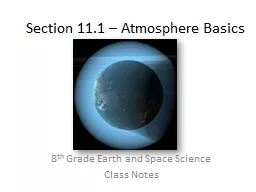/


8 th Grade Earth and Space Science Class Notes Atmosphere Basics Combination of gases dust water droplets and ice crystals Surrounds the Earth Extends from the Earths surface to outer space ID: 724206
Download Presentation The PPT/PDF document "Section 11.1 – Atmosphere Basics" is the property of its rightful owner. Permission is granted to download and print the materials on this web site for personal, non-commercial use only, and to display it on your personal computer provided you do not modify the materials and that you retain all copyright notices contained in the materials. By downloading content from our website, you accept the terms of this agreement.
Slide1
Section 11.1 – Atmosphere Basics
8th Grade Earth and Space ScienceClass NotesSlide2
Atmosphere Basics
Combination of gases, dust, water droplets, and ice crystalsSurrounds the Earth
Extends from the Earth’s
surface to outer space
Picture of the Earth’s
a
tmosphere taken
f
rom a space shuttleSlide3
Permanent Atmospheric Gases
Earth’s atmosphere consists mainly of nitrogen (78 percent) and oxygen (21 percent).
The amounts of nitrogen and
oxygen in the atmosphere are fairly constant over recent time. Slide4
Variable Atmospheric Gases
The concentrations of some atmospheric gases are not as constant over time.
The amount of water vapor, ozone, and carbon dioxide vary significantly from place to place.Slide5
Water Vapor (H
2O
(g)
)
Invisible, gaseous form of water
Can range of 0% - 4%Concentration depends on the seasons, altitude, and properties of the surface underneathSlide6
Carbon Dioxide (CO
2
)
During the past 150 years, the concentration of atmospheric carbon dioxide has increased, due primarily to the burning of fossil fuels.
Currently 0.039% (up by 0.028%)Slide7
Ozone (O
3
)
Mostly in ozone layer (20 – 50 km above)
Only 0.0012% but plays important role in blocking out harmful rays from the sun
Concentration has decreased due to CFCs
which are now banned
Scientists estimate it should
fully recover by the 2100Slide8
Atmosphere Particles
Contains variable amounts of solids in the form of tiny particles, such as dust, salt, and iceFungi and bacteria are often attached to these particles
Fluorescent sample
of bacteria taken
from the air.Slide9
Atmospheric LayersSlide10
Troposphere
Closest to the Earth’s surfaceContains most of the atmosphere’s mass
Weather occurs in this layer
Air temperature decreases with altitude
Top is called
tropopauseSlide11
Stratosphere
Above tropopause
Contains the ozone layer
Air temperature increases with altitude since the ozone layer absorbs the sun’s energy
Ends at the
stratopauseSlide12
Mesosphere
Above the stratopause
Air temperature decreases with altitude since very little solar radiation is absorbed
Ends at
mesopauseSlide13
Thermosphere
Low air density so temperature rises (can be over 1000°C)Contains the ionosphere (made up of charged particles)
Ends at
thermopauseSlide14
Exosphere
Outermost layerTransitional region between the Earth’s atmosphere and outer spaceSlide15
Review of Thermal Energy and Heat
Remember – all matter is made of particles in constant, random motion!
These moving particles contain
kinetic energy
.The total kinetic energy of the moving particles is called
thermal energy.
Less thermal
energy
More thermal
energySlide16
Review of Thermal Energy and Heat
Heat is the transfer of thermal energy from regions of higher temperature to regions of lower temperature
Direction of movement
Slide17
Energy Transfer in the Atmosphere
In the atmosphere thermal energy is transferred by:Radiation
Conduction
ConvectionSlide18
Radiation
Transfer of thermal energy by electromagnetic wavesThermal energy is transferred from the Sun to Earth by radiationSlide19
Absorption and Reflection
Incoming solar radiation is either reflected back into space or absorbed by Earth’s atmosphere or its surface.
30% reflected
20%
absorbed
by atmosphere and clouds50% absorbed by Earth’s surfaceSlide20
Rate of Absorption
Depends on physical characteristics of the surface and the amount of solar radiation
Examples – water heats and cools more slowly; dark colors absorb energy faster
Solar Radiation Around
the World
Darker = moreSlide21
Conduction
Transfer of thermal energy when objects at two different temperatures are in contactOccurs between the Earth’s surface and lowest part of the atmosphereSlide22
Convection
Remember – convection is the transfer of thermal energy by the movement of heated material from one place to another
Near the Earth’s surface air becomes heated, expands, and rises then as it rises it cools, contracts, and sinks.
This creates convection currents in the atmosphere.